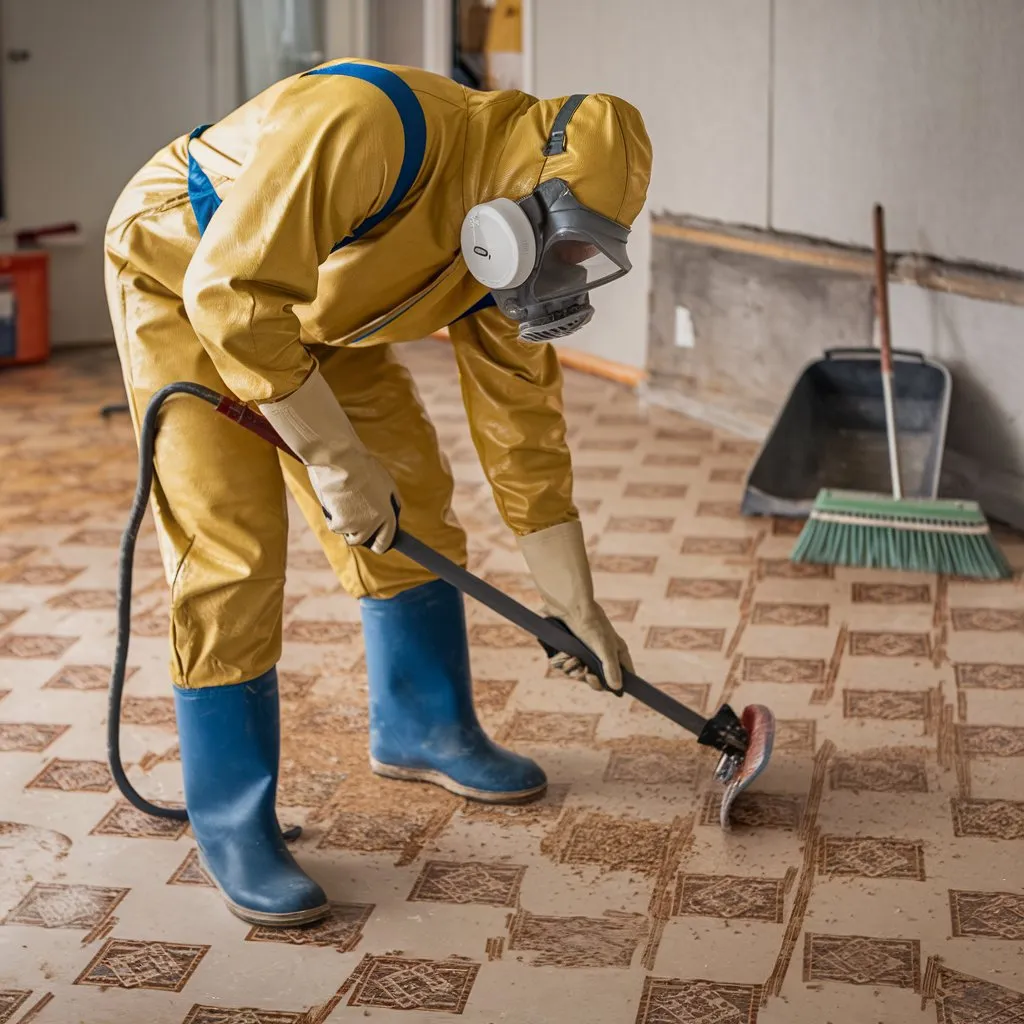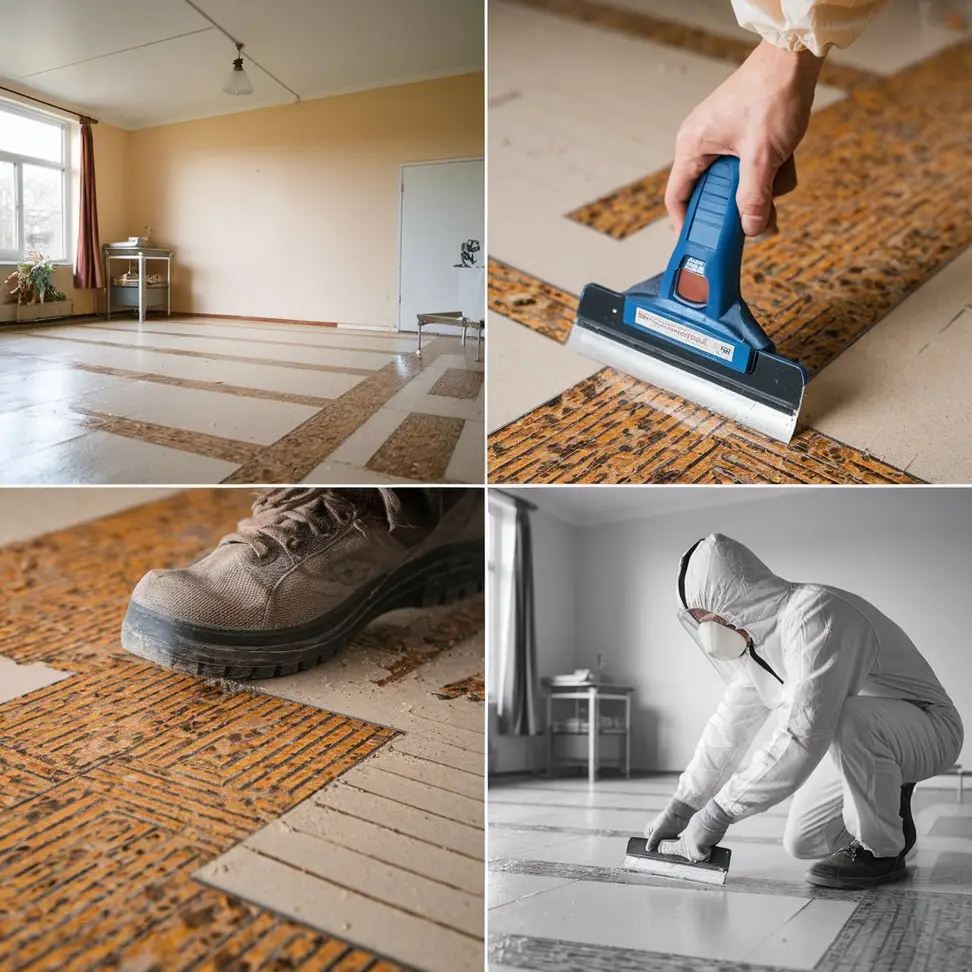Asbestos in vinyl flooring is dangerous if disturbed. You should never attempt to remove asbestos-containing flooring without proper knowledge, safety procedures, and equipment. This guide explains how to safely remove asbestos from vinyl flooring, including how to identify it, what precautions to take, and when to hire a professional.
What Is Asbestos in Vinyl Flooring?
Vinyl flooring produced before the 1980s may contain asbestos. Manufacturers added asbestos for strength and heat resistance. Asbestos may be present in the vinyl sheet, vinyl tiles, or the backing material. It can also be in the adhesive (mastic) used to glue flooring to the subfloor.
If the material is intact and undisturbed, it may not release fibers. However, during renovation, sanding, scraping, or breaking the flooring can release asbestos into the air. Inhalation of these fibers can cause serious health problems.
Why Asbestos in Flooring Is Harmful
Asbestos fibers can stay airborne for hours. If inhaled, they can settle in the lungs. The body cannot break them down. Over time, this can cause diseases such as:
- Asbestosis
- Lung cancer
- Mesothelioma
The danger increases if flooring is cut, sanded, or torn during removal. Dust and debris from these actions can contain harmful asbestos fibers.
Step-by-Step Guide to Safe Asbestos Vinyl Flooring Removal

Warning: Do not attempt asbestos removal unless you are trained and have proper equipment. In most states, asbestos removal requires licensed professionals.
Step 1: Confirm the Presence of Asbestos
Do not assume flooring is safe based on appearance. Many asbestos-containing products look similar to modern materials.
- Hire a certified asbestos inspector.
- The inspector will collect samples.
- A lab will analyze the samples to confirm if asbestos is present in the tile, sheet, backing, or adhesive.
Do not attempt sampling on your own. Improper sampling can release asbestos into the air.
Step 2: Notify Proper Authorities (If Required)
In some areas, local or state regulations require you to notify authorities before removing asbestos materials. Check local laws.
- Contact your state’s environmental or health department.
- Report removal activity if required.
- Get necessary permits.
Step 3: Prepare the Area
If removal is allowed and safe, prepare the work area properly.
- Seal the room using plastic sheeting and duct tape.
- Turn off HVAC systems to avoid spreading fibers.
- Post warning signs at entry points.
- Use negative air pressure machines (if available) to prevent fiber escape.
Step 4: Wear Proper Safety Gear
Anyone in the area must wear personal protective equipment (PPE):
- Disposable coveralls
- Gloves
- Safety goggles
- Rubber boots
- Approved respirator (P100 or NIOSH-approved mask)
Never use a regular dust mask. It will not filter asbestos fibers.
Step 5: Wet the Flooring
Before touching the flooring, spray it with water mixed with a small amount of dish soap. Keep the flooring damp during the entire process.
- Mist gently to avoid disturbing the surface.
- Avoid excess water that can cause slipping or spread fibers.
Water reduces airborne dust and helps prevent fiber release.
Step 6: Remove Flooring Carefully
There are two main parts to removal: the visible vinyl layer and the adhesive underneath.
For Vinyl Tiles:
- Use a hand scraper or putty knife to lift tiles.
- Do not break or snap tiles.
- Remove one tile at a time.
- Place removed tiles directly into heavy-duty disposal bags.
For Sheet Vinyl:
- Cut the sheet into manageable sections.
- Roll the sheet carefully to prevent cracking.
- If the backing sticks to the floor, do not scrape aggressively.
For Adhesive (Mastic):
- If adhesive contains asbestos, avoid sanding or grinding.
- Soften with steam or use a solvent approved for asbestos work.
- Scrape gently, keeping the surface wet.
Step 7: Seal and Dispose of Materials
Once removed:
- Place all waste (tiles, plastic sheeting, PPE, cleaning cloths) in approved asbestos disposal bags.
- Seal bags with duct tape.
- Label bags clearly with asbestos warnings.
- Transport waste to an authorized asbestos disposal facility.
Never throw asbestos waste in regular trash.
Step 8: Clean the Area
After removal:
- Use wet rags or disposable wipes to clean all surfaces.
- Do not use a vacuum unless it is a certified HEPA-filtered asbestos vacuum.
- Dispose of all cleaning materials in asbestos waste bags.
Do a final visual inspection to ensure no debris remains.
Step 9: Air Testing (Recommended)
After cleanup, hire a professional to test the air quality. This confirms that no harmful fibers remain.
When to Hire a Professional

Always hire a licensed asbestos abatement contractor if:
- The area is large (over 10 square feet).
- The flooring is brittle, damaged, or crumbling.
- You lack proper protective gear or experience.
- Local laws require professional removal.
Professionals have training, tools, and certification to remove asbestos safely. DIY removal without experience is dangerous and often illegal.
Legal and Safety Considerations
Asbestos removal is regulated under:
- OSHA (Occupational Safety and Health Administration)
- EPA (Environmental Protection Agency)
- State and local health departments
Violating asbestos regulations can result in fines and legal action. Always check local rules before starting removal work.
Cost of Professional Asbestos Vinyl Flooring Removal
The cost depends on:
- Area size
- Material type
- Accessibility
- Local regulations
Average range: $6 to $15 per square foot
Cost includes labor, materials, safety gear, and disposal.
Conclusion
Removing asbestos from vinyl flooring is dangerous if not done properly. It is important to confirm the presence of asbestos through professional testing. If removal is necessary, follow strict safety steps or hire licensed professionals. Do not cut corners. Safe removal protects your health and ensures compliance with the law.
If you suspect asbestos in your flooring, act early. Avoid disturbing the material, and always prioritize safety.
Contact Us For more Info
Email: [email protected]
Phone Number: +937 252-4724
Address: 2617 S Smithville Rd, Dayton, Oh, United States

Dr. Chris Cameron is a leading asbestos expert with over two decades of experience in occupational and environmental health. He holds a Ph.D. in Environmental Science and has worked extensively with government agencies, private sector organizations, and health and safety regulators to assess, manage, and mitigate asbestos-related risks. Dr. Cameron is widely recognized for his research on asbestos exposure, remediation strategies, and public health policy